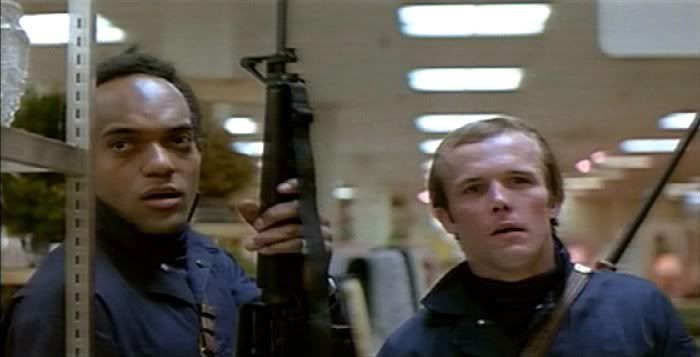 Substituting its predecessor’s rural locale for a large shopping mall, ‘Dawn of the Dead’ (1979) is the most darkly humorous of the series. Opening with scenes of chaos in a TV station which is remaining operable as long as possible to broadcast updates, it is evident from the start that the localised occurrences of ‘Night of the Living Dead’ are now a national phenomenon.
Substituting its predecessor’s rural locale for a large shopping mall, ‘Dawn of the Dead’ (1979) is the most darkly humorous of the series. Opening with scenes of chaos in a TV station which is remaining operable as long as possible to broadcast updates, it is evident from the start that the localised occurrences of ‘Night of the Living Dead’ are now a national phenomenon.Two people, a production assistant and her helicopter pilot boyfriend, flee the studio. Joined by two members of a SWAT team, who run up against a group of zombies whilst battling a group of well-armed criminals (another indication of societal values breaking down), the foursome seek refuge in a shopping mall. The logic is clear: stuffed to the gills with material goods and foodstuff, it is the ideal, self-contained place to hole up.
Essentially, then, ‘Dawn’ shares the same scenario and internal dynamics as ‘Night’: much of its running time plays out within the confines of one specific setting (mall here as opposed to farmhouse), and most of its dramatic import derives from a group of thrown-together survivors trying to pull together but ultimately fragmenting while the zombies gather outside.
However, the scale is larger in ‘Dawn’; the action much better orchestrated. Arriving at the mall, the dead are already inside. They have to be taken care of. The entrances have to be secured and barricaded; delivery bays sealed off using trucks abandoned in the parking area. A gun shop is raided; gleeful hunt and kill expeditions ensue. Zombies dealt with, the next threat our increasingly fractious quartet are forced to contend with is an invasion by a biker gang (a corollary to the gun-toting hicks who kill Ben in ‘Night’).
This plethora of problems solved, the mid-section develops into an effective satire of materialism. A blockade established against the zombies, all they want in terms of necessities and luxuries alike theirs for the taking, they nonetheless lose little time in falling out and falling apart. Internal tensions are exacerbated; emotions run high. Eventually, the sheer numbers of their undead antagonists prove plentiful enough to force their way in.
By the end there are only two survivors. Returning to the roof they landed on and the helicopter that brought them there, they make their departure even though they know that fuel is low and their destination uncertain. For all that, the last shot of ‘Dawn’ is as funny as that of ‘Night’ is bitter: a shuffling parade of zombies riding up and down the department store escalators to the accompaniment of chintzy muzak. You don’t have to be a film student to see Romero’s point.
“When there is no more room in hell,” runs the film’s most oft-quoted line, “the dead will walk the earth.” Perhaps more apposite is this exchange:
“Why have they come here?”
“Instinct; memory. It’s what they used to do. This was an important place in their lives.”
It’s a concept that links into ‘Day of the Land’ and provides a virtual mission statement for ‘Land of the Dead’.







































No comments:
Post a Comment